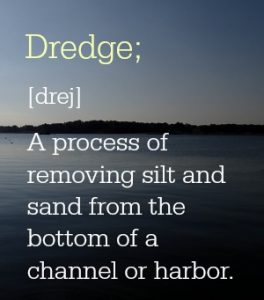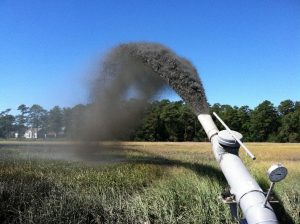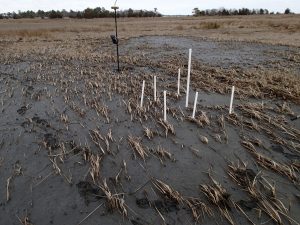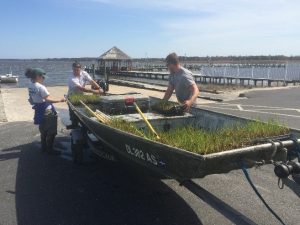
Facebook Twitter Instagram YouTube
Written on: May 24th, 2017 in Education and Outreach, Wetland Restoration
By Brittany Haywood, DNREC’s Wetland Monitoring and Assessment Program
What is one way to give a marsh a lift with the challenge of rising seas? Spray the muddy material that has been dredged up from the bottom of a creek in a thin layer on top of the marsh. But how much mud is too much, and can the plants survive? These are a couple of the questions we (Wetland Monitoring & Assessment Program) set out to answer.

In 2013, Pepper Creek in Dagsboro was set to be dredged, so we rallied the troops and came up with a plan to test out how the beneficial reuse of dredge materials (also called thin layer application) affect marshes in Delaware. The resulting spoils from dredging were thinly sprayed over the marsh at the Piney Point Tract of the Assawoman Wildlife Area, and long term monitoring stations were set up.
For the past three years we have been looking at how the plant community has responded to the application, and how the marsh surface has changed by performing Real Time Kinematic (RTK) GPS transect surveys of the area and measuring surface accretion with feldspar marker horizon plots.

From the data we have been gathering we’ve figured out a couple of things that work and some things that need further study for future projects:


Establish a limit to the amount of mud that can be sprayed in the application area. For our area, we suggest approximately 10 to 12 centimeters. The plants in areas that were more thickly sprayed with mud still struggle to grow through the mud. To supplement these thickly applied areas, we planted 2600 smooth cordgrass (Spartina alterniflora) plugs to try and fill in the bare areas. We even started a mini-experiment to see if planting in clumps verses rows allows the little beauts to survive better. We’re still collecting data on the mini-experiment, but hope to have some interesting results soon.
Once the thin-layer of sediment has been applied to the marsh surface, it takes time for the muddy water to level out across the marsh and for the suspended sediments to fall out of the water. More information is needed on how mussels respond to being covered with mud. How thick is too thick for them?
So the nitty gritty of it is that spraying dredge materials on top of a marsh can increase the height of that marsh. But, careful attention must be paid to how thickly the mud is sprayed, and the site should be monitored for problem areas that need replanting.
This project was done in partnership with DNREC’s Shoreline and Waterway Management Section. For more information or questions about this project, please contact Alison Rogerson at alison.rogerson@delaware.gov or 302-739-9939.